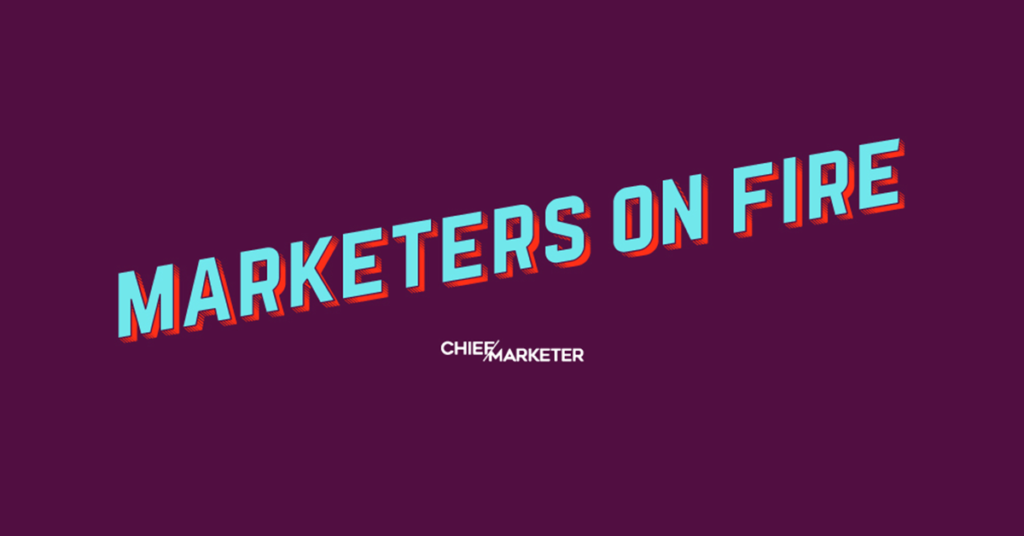Marketers on Fire: HBO Program Marketing VP Steven Cardwell
Our monthly profile of an outstanding marketer whose leadership and campaigns are moving the needle for their brand.
—

If you attended CES in January—or read anything about the buzz surrounding it—you likely heard about HBO’s eerie, invite-only “Westworld”-themed dinner held by a fictional start-up company called Incite. Even reading the recaps sends shivers down the spine. Words and phrases like “terrifying,” “the ultimate creep session” and “a horoscope on steroids” were used to describe the evening, which designed highly-personalized experiences for each attendee after an impressive amount of digital digging done by the network and agency partner Giant Spoon.
“We spent months studying every single person who RSVP’d, mining their social and digital footprint to glean anything we could to give them a taste (literally) of a not-so-distant world in which over-personalization reigns,” says Steven Cardwell, HBO’s program marketing vp behind the project. Imagine being greeted by name by a host whom you’ve never met; a waiter who knows the ins and outs of your personal life; and menus reflecting your preferred tastes. Not to mention the kicker: a bill holder as a parting gift, embossed with your initials and containing a prediction of how your life and career would play out—and even how long you would live.
Intrigued? So were we. It’s all part of Cardwell’s program marketing strategy at HBO, which follows an unwavering commitment to authenticity of content. Responsible for marketing some of the most buzzworthy shows this decade has seen, including the HBO series’ “Game of Thrones” and “Westworld,” Cardwell tackles each with empathy for the viewership, engagement of its super fans, personalized experiences and an eye toward giving back to the community.
And, of course, innovation. With the number of scripted television series in the United States exceeding 500 last year, the stakes for marketers promoting content to consumers couldn’t be higher. “There’s a lot of choice out there. And we’re competing not just with other shows, but with other screens,” Cardwell says. “We have to be constantly innovating in how we not only approach marketing, but how we think about the consumer and what they want to do.”
LEVERAGING PERSONALIZATION
Activating at CES was a natural way for HBO to join the data-dominated conversation happening at the trade show. “Data privacy was the hot button issue at CES this year, so showing up as Incite, a company featured in the upcoming season of ‘Westworld,’ helped insert ourselves into the conversation organically,” Cardwell says. The series deals with the implications of developing artificial consciousness—and how that can sometimes result in negative consequences for the human beings that created them—so it was smart to activate at CES, a show celebrating robotic personal assistants and AI-fueled gadgets that are supposed to make our lives better.
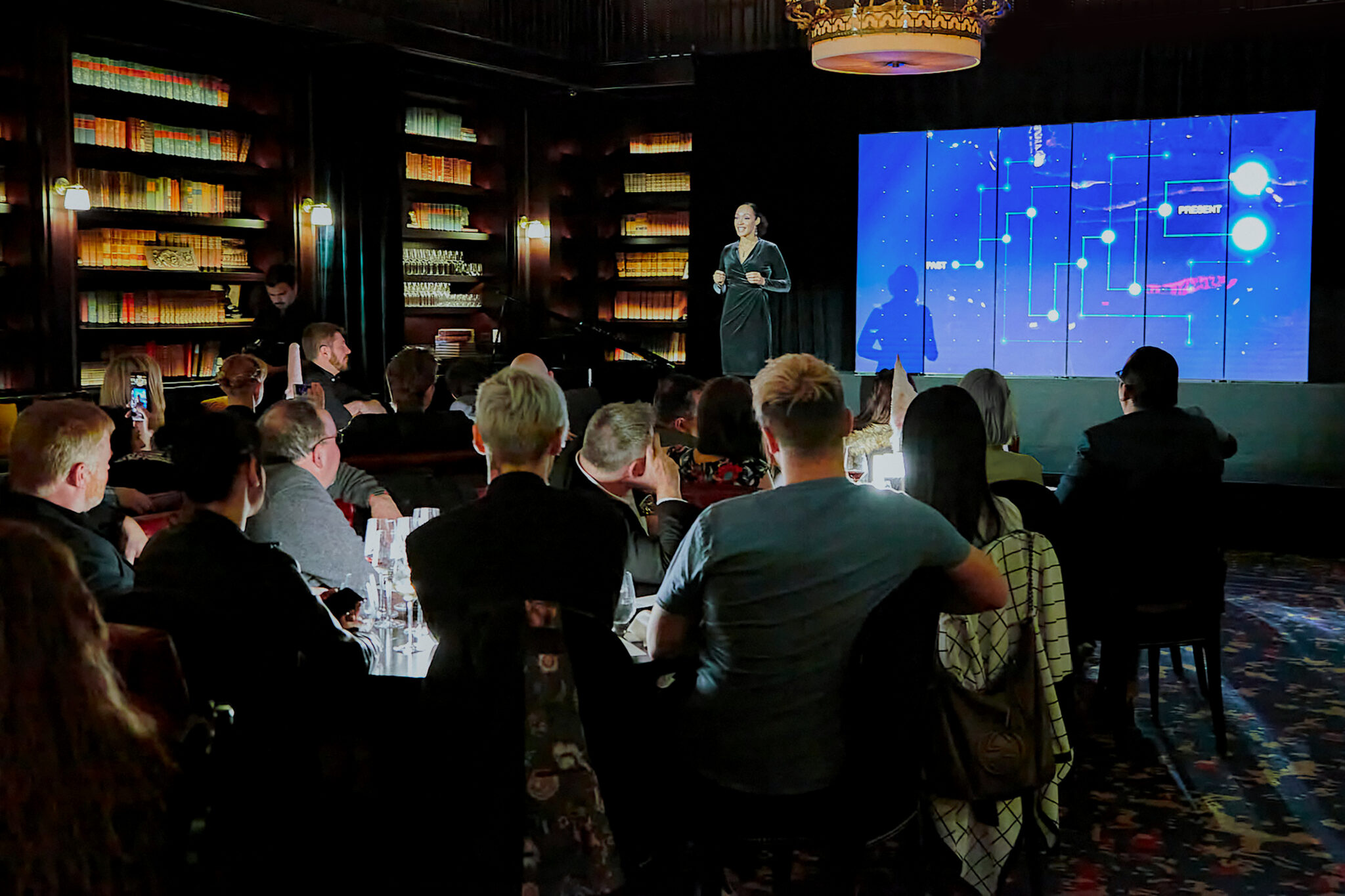
But it was a risk to show the potential dark side of data while executives from major tech companies were citing efforts to protect consumer privacy. Cardwell says the sell was always positive, with Incite’s pitch being a kind of “help us help you” scenario. “As we presented the dinner, it was a pitch for the future… They can take your data and help make decisions for you, just like an algorithm would help you decide what you want to watch,” Cardwell says. While executives pontificated on panels about the state of data privacy, the network took a show rather than tell approach through creating an immersive experience.
It’s not the first social experiment created in the name of “Westworld.” The brand pulled out all the stops at SXSW 2018 with its “SXSWestworld” activation, a 90,000-square-foot literal theme park built 30 miles outside of Austin as a replica of the luxury destination featured in the series. The attention to detail was mind blowing, with a total of 444 pages of script, 66 actors and a unique mission and a personalized journey given to each of the activation’s thousands of attendees. Puzzle solving began immediately, with those cracking the code arriving by luxury Lyft or even an actual Delta flight to the park. Super fans could delve even further into the narrative by discovering the dozens of Easter Eggs hidden on the grounds, each offering clues about the upcoming season. It earned 1.9 billion impressions, tons of press and buzz, and Event Marketer’s 2019 Grand Ex Award.
The decision to take guests off site wasn’t an easy one, according to Cardwell. But ultimately, the challenge turned into an asset. “We debated for days if people would give up a few hours of their busy SXSW schedules to be bussed to a town 30 minutes outside of Austin. We knew that if we were going to get people to spend hours with us, we better maximize their time and give them a truly one-of-a-kind and unforgettable experience,” he says. Embracing the journey and allowing the experience to fully play out paid off—despite people lining up for six hours to get in. “Part of the allure of Westworld is that it’s a luxury destination, so creating the sense of a journey to Westworld was part of the success of making it feel real,” he says.
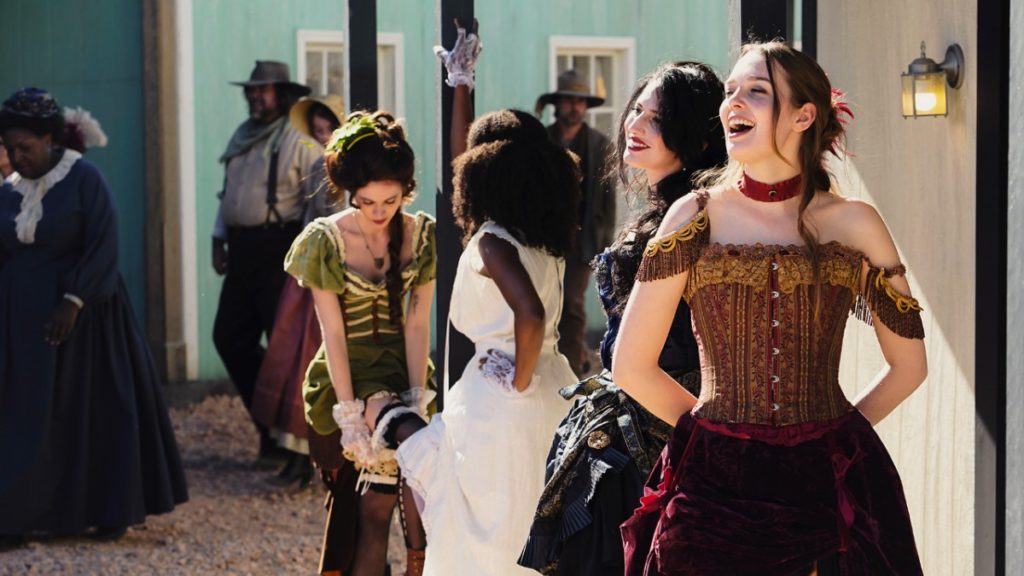
FINDING INSPIRATION
For Cardwell, each project begins with a few questions. “Before we embark on any kind of marketing activation, we ask ourselves a seemingly obvious question: ‘Why are we showing up?’ Are we servicing fans? Are we driving awareness to bring in new viewers? Are we promoting conversation and dialogue? Are we giving back to the community?” The team also considers what the bar to entry will be for consumers and whether that needs to be made higher or lower to maximize engagement.
Cultural trends don’t shape his team’s creativity choices—but consumer trends do. “We look at different kinds of trends: How is consumption of content changing? What are the viewing behaviors of our viewers? What are our fans passionate about? Once we have a solid understanding of these questions, we go out and build great campaigns and experiences that ladder up to our strategic goals,” he says. He also appreciates the work of brands that are innovating in the marketplace, like Spotify, Burger King and Casper. Burger King for its “Whopper Detour” campaign requiring consumers to visit a McDonald’s before unlocking a free Whopper coupon; Spotify for its clever out-of-home ads that play with the company’s user data points; and Casper for creating puzzles and gamifying its New York City subway ads for commuters.
Cardwell has long had a passion for premium content. Early on, he cut his teeth working for the Academy and Tony Award-winning producer Scott Rudin, known for “No Country for Old Men,” “The Social Network” and Broadway musical “The Book of Mormon,” to name just a few productions. There he got a crash course in everything from development to production to publicity to marketing. “Because he was such a hands-on producer, I got a front row seat into how a movie gets produced and released. It was there that I really got interested in marketing,” Cardwell says.
Then, when “The Book of Mormon” came to town, Rudin made him marketing director for the show. “Suffice to say I didn’t know much—anything, really—at 25 about bringing a musical to Broadway, but that’s the kind of producer Scott is. It was a sink or swim moment. I had to quickly learn everything I could in a very short period of time.”
Later on, Cardwell moved on to IFC Films to oversee theatrical marketing campaigns for 30 or so films, including Richard Linklater’s “Boyhood.” By then Cardwell’s passion for premium content had solidified, so when an opportunity came along to work for HBO in program marketing in 2015, he jumped at the chance.
LEAN INTO EXPERIENTIAL
What’s the secret to Cardwell’s HBO’s success? Experiential marketing’s ability to go beyond the confines of a piece of content and open up new storylines plays a significant role. A particular series being promoted is finite—available for consumption in 30- or 60-minute increments—but the ideas and concepts attached to those storylines are far from it. “We are able to build on very complex and layered story worlds that our show writers create… and maybe go and explore other avenues that we might not have had time to get to in an episode,” Cardwell says. “In a world that is more increasingly digital, sometimes bringing people out of their phones, out of their screens and into those worlds to make them feel something can be a really powerful thing.”
Super fans can absolutely help with that—particularly when a series is based on existing IP, like “Game of Thrones.” For Cardwell, super fans are one of the most important elements of the network’s engagement strategy. “If you don’t have the early hand-raisers, fans of an IP or talent on board, you’re never going to build the momentum necessary to broaden out and bring in new viewers to the show. Credibility is paramount when it comes to fan engagement. You lose the fans and you’re doomed,” he says. With GOT, is was about courting the book fans first—speaking to them early and giving them access to content first. “You’re turning them into our evangelizers. They’re the ones that are going to start that word of mouth train. They do a lot of lifting.”
When it comes to keeping fans engaged in between seasons, which can amount to a hiatus of up to 18 months, tactics tend to be show-specific. For “Game of Thrones’” final season, Cardwell and his team wanted the campaign to be celebratory. But starting it seven months out presented a challenge since there was no footage to use to promote the new season. The solution: a massive integrated marketing campaign, dubbed #ForTheThrone, that saw other brands jumping at the chance to promote the series’ final chapter.
Here’s how it worked: With each new season, HBO is approached by brands seeking to partner with the network in order to tap into the cultural frenzy taking place among “Game of Thrones” fans. This time around, Cardwell and his team decided to put out a brief to other brands asking what they’d be willing to sacrifice for the throne. Just as the campaign asked fans what they’d do for the throne, other brands were challenged to devise a sacrifice as well.
And boy did they deliver. Budweiser agreed to kill its mascot, Bud Knight, in a duel that took place during a Super Bowl commercial. Mountain Dew sacrificed its branding by creating “A Can With No Name” that was completely white at room temperature but revealed Aria Stark’s kill list when chilled. Oreo recreated the series’ opening sequence entirely out of Oreo cookies (see below). And Shake Shack required customers to unlock free menu items by ordering them in the language of Valyrian. The list goes on. HBO reports that 26 percent of all “Game of Thrones” conversations referenced the #ForTheThrone campaign, averaging 30 social mentions per minute over a six-month period. Not to mention 19 billion earned media impressions.
Interested collaborators may be wondering if a similar integration will occur with an HBO series in the future. Perhaps. But for Cardwell it’s not about expanding reach and getting more eyeballs. “For us, it’s understanding what the brand and HBO together symbolize. In the case of ‘Game of Thrones,’ the tie-ins were clever and felt organic. There was no money exchange, no partnership agreements, no licensing deals. This was strictly about fandom and love for the IP. And I think when we can combine our brand and another brand and elevate both, that’s something that we’re interested in.”
Measuring success of a marketing initiative is campaign-specific as well. “With SXSWestworld, it was about capturing the imaginations of an entire conference, inspiring that kind of ‘you just had to be there’ status,” Cardwell says. “For the Super Bowl, it was about subverting viewers’ expectations by surprising and delighting them with a true ‘Game of Thrones’ ending.”
And for its cause marketing campaign with the American Red Cross, called “Bleed for the Throne,” the metrics went beyond social impressions and focused on “harnessing the amazing community of fans to band together and save some lives,” according to Cardwell. Spawning from the #ForTheThrone campaign platform, the activation consisted of a series of nationwide blood drives and an experiential activation at SXSW 2019 in which consumers were asked to put their fandom to the test—and bleed for the throne.
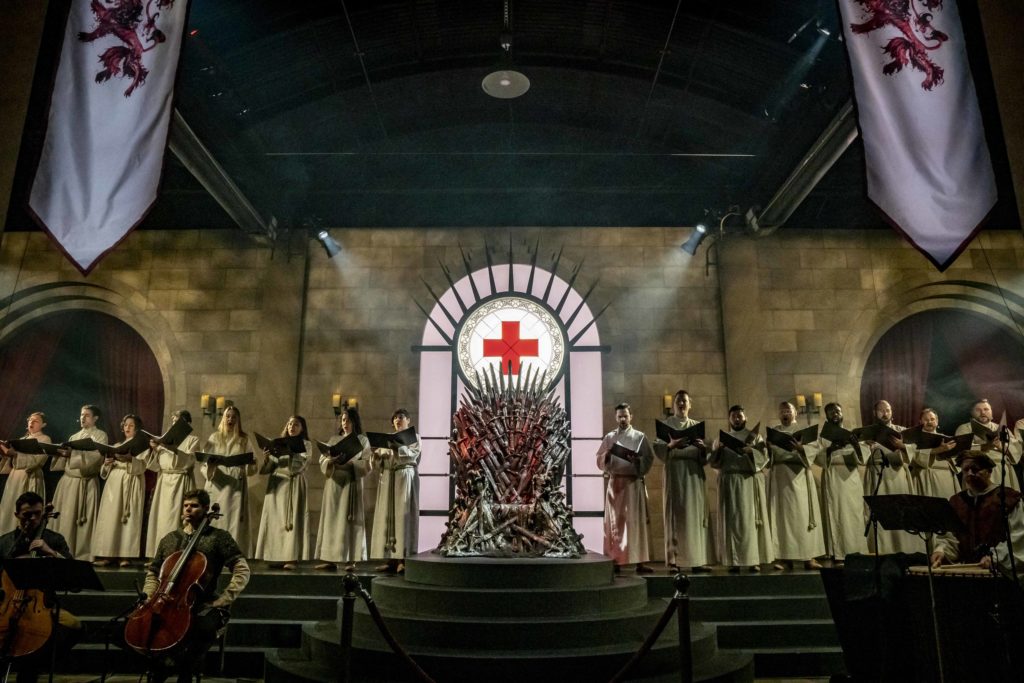
This one was all about giving back. Particularly harsh winter weather that season has resulted in the closure of many blood drives, causing the Red Cross to experience a blood shortage. Enter “Game of Thrones” to seize upon a particularly noble cause-marketing tie-in in which fans were asked to sacrifice their own blood in the name of the throne. A total of 350,000 blood donations were collected, representing a 12 percent increase overall and a 21 percent uptick in first-time donors. Thanks to 43 states participating across the country, the Red Cross recovered 13 times what it had lost during the shortage. Talk about a worthy sacrifice.
EMPATHY AS A NORTH STAR
The aforementioned campaigns for “Game of Thrones” were larger than life—perhaps even lifesaving. But Cardwell’s marketing strategy is not about being the biggest. It’s about establishing an emotional connection. “The stakes are always high when it comes to anything we’re putting out in the market, be that a trailer, a piece of key art or an experiential activation. There are so many choices for consumers in the marketplace,” he says. “We need to make sure that whatever we’re doing is attention grabbing, thumb-stopping, meaningful and has emotional resonance. It just can’t be a drop in the bucket. It’s not ‘go big or go home,’ it’s, ‘if you’re going to show up, show up well or don’t do it at all.’”
In the case of the HBO series “Euphoria,” that meant taking a subtler marketing approach. The show tackles teen drug abuse, sexuality and gender fluidity and has attracted a younger audience than the network typically brings in. “Given the sensitive subject matter, we wanted to make sure that we were allowing the show to speak for itself, because there’s a lot of nuance. We wanted our marketing to reflect empathy and understanding for these kids [and let] the show be the voice rather than the marketing,” Cardwell says. HBO focused more on post-premiere initiatives and show continuity, playing more in the social media and CSR spaces.
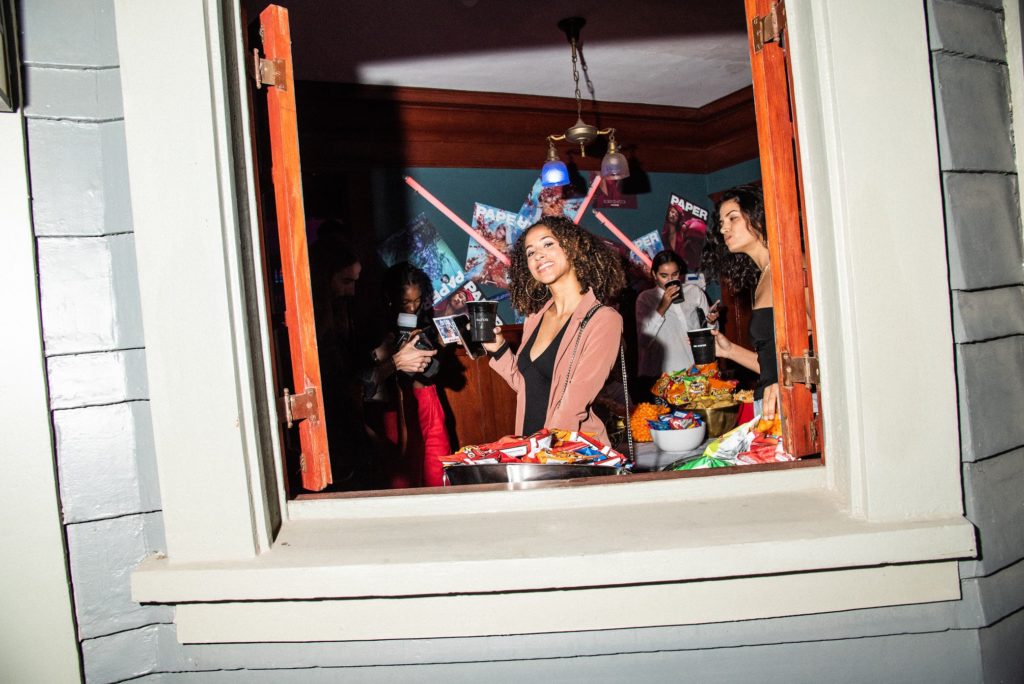
For instance, to reflect a sense of empathy among a younger audience demographic, the network created a resource page for show viewers that provided information on various organizations, from The Trevor Project to the National Alliance on Mental Illness. The team also produced an intimate conversation between lead actress Zendaya and the show’s creator, Sam Levinson, discussing the issues facing many teens today. “Empathy is our North Star,” Cardwell says. “We wanted it to feel real and relatable, not over-stylized or over-glamorized.”
No matter the project or subject matter, Cardwell’s strategy is centered around authenticity and a fierce attention to detail. “The challenge always remains the same across everything we do: being 100 percent authentic and speaking in the voice of our shows or the HBO brand. The moment we’re not, or the moment we overlook one detail, the experience or activation falls completely flat.”
We’re excited to see where Cardwell will take HBO’s program marketing next. If the future looks anything like the data-fueled social experiment the industry raved about at CES, we’re in. (But of course, they saw us coming.)
